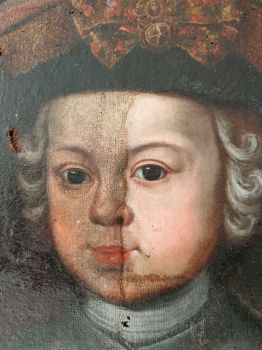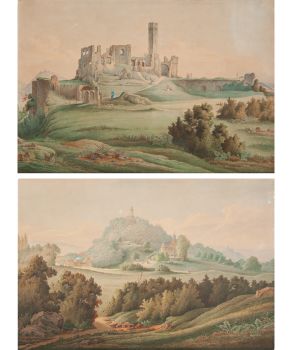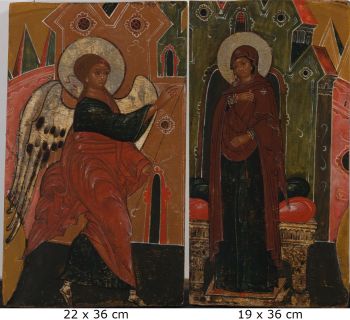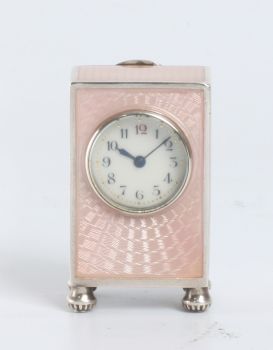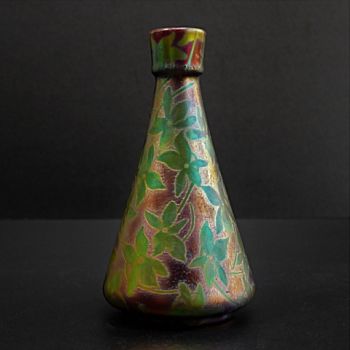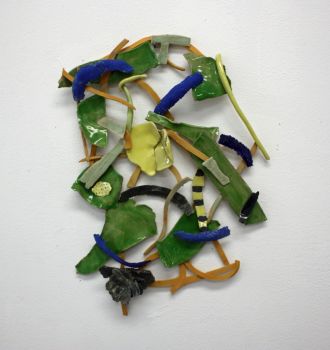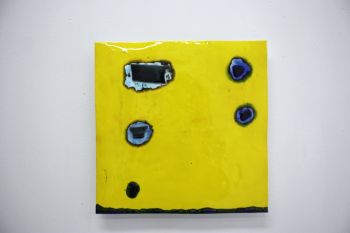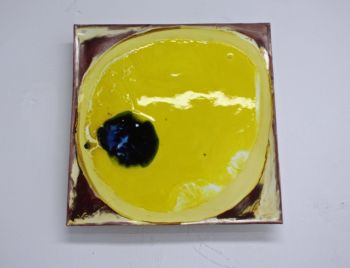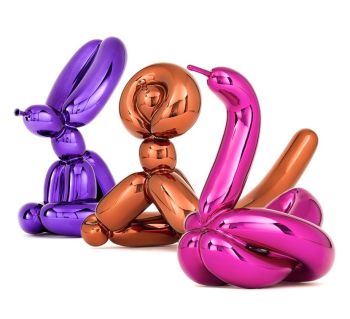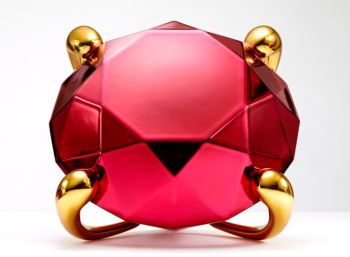Japanese porcelain blue and white ‘Van Frytom’ tea bowls and saucer dishes, Edo period, c. 1690-1710 1690 - 1710
Unbekannter Künstler
Japanisches PorzellanPorzellan
3.40 cm, ø 13 cm
ConditionVery good
Preis auf Anfrage
Menken Works of Art
- Über KunstwerkA set of seven ‘Van Frytom’ tea bowls and saucer dishes.
Japan, Arita, Edo period, c. 1690-1710.
The rare set consisting of three tea bowls and four saucer dishes with matching decorations in underglaze blue in the style of Dutch Delft painter Frederik van Frytom.
The bowls with spreading sides and everted rim, decorated in underglaze blue, on the outer body with a Frysian “kop-staart-rompboerderij” (translation: Head-Neck-Body farmhouse) and two figures standing next to each other in a landscape, the inner and outer rim with washed-blue bands. The well on the inside decorated with a figure standing in the grass with trees and a house. A typical stylized four-character Chenghua mark to the base.
The dishes in the form of a flower with foliated rim. Decorated in underglaze blue, similar to the bowls, with a Frysian “kop-staart-rompboerderij” and two figures standing next to each other in a landscape with grass, trees and clouds in the sky. The inner rim with a washed-blue band, the base with spur marks and a six-character Chenghua mark.
Ref:
A.Vecht, Frederik van Frytom 1632-1702, Life and work of a Delft pottery decorator, No. 40-44.
A pair of ‘Van Frytom’ style tea bowls are in the Metropolitan Museum of Art collection, accession number 2002.447.118 and accession number 2002.447.119. These are also illustrated in Japanese Art from the Gerry Collection in the Metropolitan Museum of Art, p. 116, pl. 95a,b.
For another tea bowl with this design, see: The Burghley Porcelains, An Exhibition from The Burghley House Collection, pp. 158-159, pl. 54.
A similar saucer dish is in the collection of The Burghley House, reference: CER0473
For a tea bowl and saucer dish of the same style but with a river scene, see the Twickel Castle collection, Delden, no. JK 13, illustrated in: Fine and Curious (Christiaan J.A. Jörg) pp. 244-246, pl. 317-317a.
Two similar dishes were also sold at Christie’s, 19 Dec 2014, lot 85.
Dimensions:
Bowls: Diameter 7.4 cm, height 3.4 cm.
Saucer dishes: Diameter 13 cm, height 2.5 cm.
Condition:
Very good condition, without damages.
Worldwide registered and insured shipping.
Take a look at our other listings for more Asian art and antiques.
Inv. No: MW107 - Über Künstler
Es kann vorkommen, dass ein Künstler oder Hersteller unbekannt ist.
Bei einigen Werken ist nicht zu bestimmen, von wem sie hergestellt wurden, oder sie wurden von (einer Gruppe von) Handwerkern hergestellt. Beispiele sind Statuen aus der Antike, Möbel, Spiegel oder Signaturen, die nicht klar oder lesbar sind, aber auch einige Werke sind überhaupt nicht signiert.
Außerdem finden Sie folgende Beschreibung:
•"Zugeschrieben …." Ihrer Meinung nach wohl zumindest teilweise ein Werk des Künstlers
•„Atelier von ….“ oder „Werkstatt von“ Ihrer Meinung nach eine Arbeit, die im Atelier oder in der Werkstatt des Künstlers, möglicherweise unter seiner Aufsicht, ausgeführt wurde
•„Kreis von ….“ Ihrer Meinung nach ein Werk aus der Zeit des Künstlers, das seinen Einfluss zeigt, eng mit dem Künstler verbunden, aber nicht unbedingt sein Schüler
•"Art von …." oder „Anhänger von ….“ Ihrer Meinung nach eine Arbeit, die im Stil des Künstlers ausgeführt wurde, aber nicht unbedingt von einem Schüler; kann zeitgenössisch oder fast zeitgenössisch sein
•„Art von ….“ Ihrer Meinung nach ein Werk im Stil des Künstlers, aber späteren Datums
•"Nach …." Ihrer Meinung nach eine Kopie (jegliches Datums) eines Werks des Künstlers
• „Unterzeichnet …“, „Datiert …“. oder „Beschriftet“ Ihrer Meinung nach wurde das Werk vom Künstler signiert/datiert/beschriftet. Das Hinzufügen eines Fragezeichens weist auf einen Zweifel hin
• „Mit Unterschrift …“, „Mit Datum …“, „Mit Aufschrift ….“ oder „Trägt Unterschrift/Datum/Beschriftung“ ihrer Meinung nach die Unterschrift/Datum/Beschriftung von jemand anderem als dem Künstler hinzugefügt wurde
Sind Sie daran interessiert, dieses Kunstwerk zu kaufen?
Artwork details
Related artworks
Unbekannter Künstler
A large wall map of Asia by Nicolas de Fer 1647 - 1720
Preis auf AnfrageZebregs & Röell - Fine Art - Antiques
1 - 4 / 12Unbekannter Künstler
A rare Japanese export lacquer medical instrument box1650 - 1700
Preis auf AnfrageZebregs & Röell - Fine Art - Antiques
Unbekannter Künstler
The Stamford Raffles Secretaires.1800 - 1813
Preis auf AnfrageZebregs & Röell - Fine Art - Antiques
1 - 4 / 21- 1 - 4 / 24
Samuel Dejong
Anatomia Blue Heritage, Atlas Closed2017 - 2019
Preis auf AnfrageVilla del Arte Galleries
Unbekannter Künstler
A large Japanese Imari porcelain 'VOC Groningen' dish1800 - 1925
Preis auf AnfrageZebregs & Röell - Fine Art - Antiques
Unbekannter Künstler
Series of 6 Chinese cups and saucers (Yongzheng period)1722 - 1735
Preis auf AnfrageKuipers Kunst & Antiek
1 - 4 / 24Unbekannter Künstler
A white jade ‘Lotus Seedpod and Bug’ carving, Qing dynasty, 18th century18th century
Preis auf AnfrageMenken Works of Art
Unbekannter Künstler
Chinese gilt bronze censer, Xuande mark, 18th century, Qing dynasty18th century
Preis auf AnfrageMenken Works of Art
1 - 4 / 9













